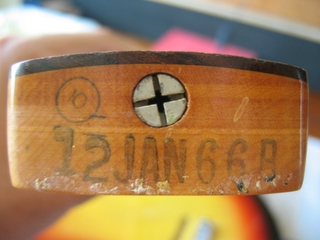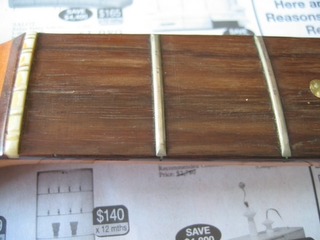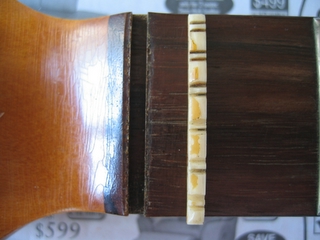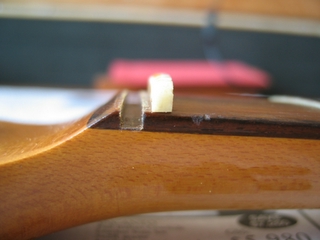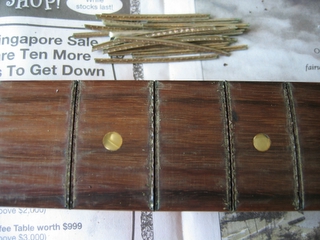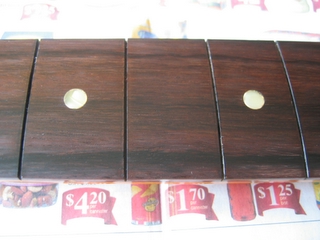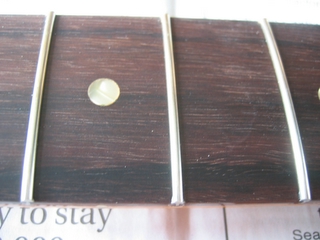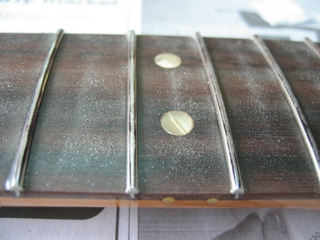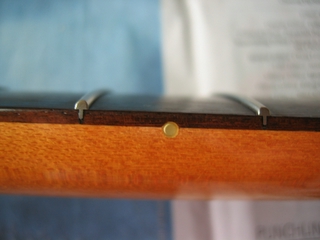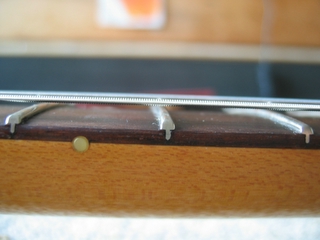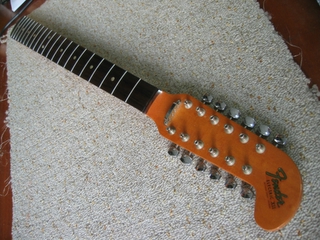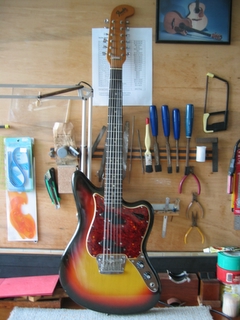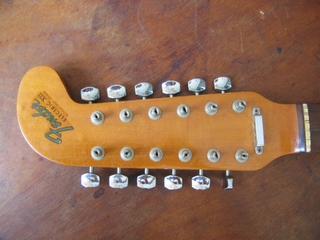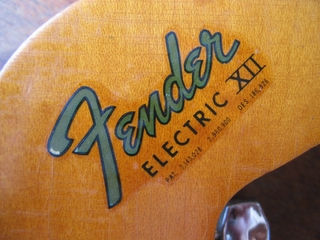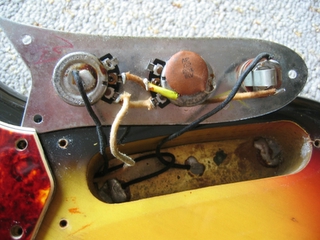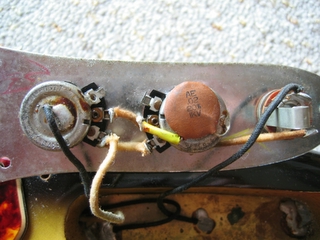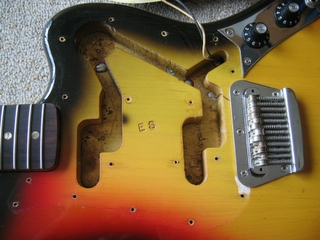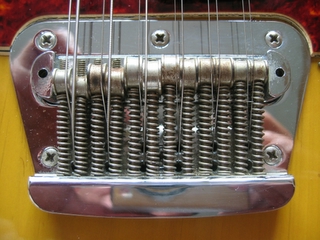|
The subject
guitar is a 1966 Fender XII. Note the round laminated Rosewood
fingerboard. The frets
are slightly worn but since the frets have been dressed pretty low to begin
with, the neck is not very comfortable to fret. I still donít understand why
Fender and Gibson dresses their frets so aggressively. Vintage Fenders also
usually come with extensively beveled fret ends. |
|
Before sanding the fingerboard level, the nut has to be
removed. I usually make a replacement nut but in order to maintain the
originality of the subject instrument, the owner and myself have decided to
use the original nut, which will be shimmed with a piece of Maple later as
the new frets are about .020Ē taller than the original frets. Care is taken
to ensure that the original nut is removed cleanly from the nut slot. |
|
The frets
are removed and thank God there wasnít any major chips along the fret slots.
It takes patience and experience to remove the frets cleanly without serious
chipping. Most of the time, one does experience some chips along the fret
slots, I just got lucky this time. |
|
Check out
the nice figure of the Brazilian Rosewood fingerboard. Is this the same
fingerboard as above??? Yes it is. It looks brand spanking new doesnít it?
Over the years, Iíve developed a special treatment thatís administered to the
fingerboard immediately after the frets are removed to strengthen the
integrity of the fret slots so theyíre good as new! The
fingerboard is then perfectly finish sanded, fret slots cleaned up and re-cut
if necessary. Weíre now ready to fret. Thanks to the both intensive and
extensive prep work, only a very light fret dress is usually required or in
some cases, no dressing is needed. I
personally feel it defeats the purpose to re-fret a neck when the new frets
are dressed too excessively. Most mass produced guitars have their frets
dressed too much. Slightly more than 1/4 of the fret height is sanded away on
most mass produced guitars. Youíre taking away at least a year of play when
that happens. One of the reasons is due to inexperience and because the
fingerboard was not perfectly leveled before fretting thus the frets are not
level with one another. |
|
The neck
is fretted and the fret ends filed almost flush with the edge of the
fingerboard. |
|
Note how
lightly the frets have been dressed thanks to an immaculate prep job prior to
fretting. The frets are seated perfectly and level with one another. Iím very
particular about fret dressing and pay a lot of attention so I donít remove
more than necessary material. |
|
The frets
are slightly beveled in relation to the edge of the fingerboard and lightly
rounded to remove any sharp edges. Note the perfectly rounded fret top and
ends. |
|
The neckís
ready to be fitted back to the body. |
|
The guitarís strung up and ready to go. The action is low and
effortless and the guitar sounds incredible. Iím jonesing for a 12 string
electric. |
|
Hereíre
some details of this very unique and one-of-a-kind instrument. We start off
with the headstock and close up of the decal. |
|
The electronic and pickup cavity. Note the copper shielding
plate at the bottom of both cavities. |
|
Close up
of the bridge. Note the individual saddles for accurate intonation. |
|
Hereís the
customerís comment on the guitar. Hello
Malcolm I've
come to you again on my Fender Electric 12 because you certainly live up to
your claims and treat all instruments like your own. My cousin bought this
for me used, from Vancouver while she was doing mission work during the
"12-string" phase of my life. After realizing it was a 1966 vintage
relic, I was not about to let some ham-fisted "luthier" at Selegie
Road or anywhere toy with it even though I was told that many people send
their instruments there. Well, my sympathies to them because they donít know
what first-rate workmanship truly is! The action is perfect and I'm able to
barre it from the first to the very top position with little effort. You've
thoughtfully dressed the fret ends in a way that has left me with much more
playing area than the original. The intonation is even better than the
original and it sounds sweeter too even in extreme positions. It's the best
money I've ever spent on a re-fret and I'll not hesitate to recommend your
services to anyone who is serious about their instruments. Thanks again for
an excellent piece of work. Ewen
- June 2005 |
